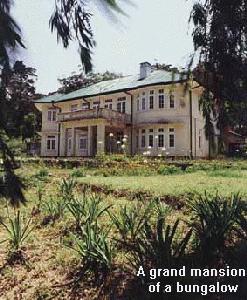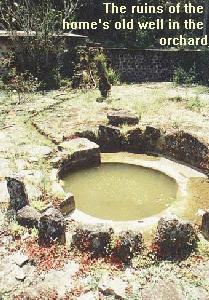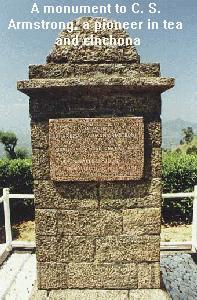

![]()
 Many
are the plantation bungalows whose testimony remains untold because the
records, like their pioneering occupants, have disappeared. Yet, at Hewaheta,
there is a grand mansion of a bungalow whose history casts doubt on the accepted
version of the origins of tea growing in Sri Lanka.
Many
are the plantation bungalows whose testimony remains untold because the
records, like their pioneering occupants, have disappeared. Yet, at Hewaheta,
there is a grand mansion of a bungalow whose history casts doubt on the accepted
version of the origins of tea growing in Sri Lanka.
The popular belief attributes to Scotsman James Taylor the first commercial planting of tea seed in Ceylon in 1867 at Loolecondera near Deltota.
While there is no doubt about Taylor's deeds, a few miles further south, at Hewaheta, the Rookwood bungalow stirs memories of another planter, Charles Spearman Armstrong. There is a monument there in granite blocks declaring that Armstrong, born in 1847, was a pioneer in tea and cinchona, from 1864 to 1908.
The 10-room mansion that stands at Rookwood today is not the original one Armstrong built. Its impressive exterior with modest bay windows and wing jutting from the front side, dates from the mid-1950s.
This is one of those two-storey plantation houses confusingly called a bungalow, to the delight of planters and to the annoyance of the pedantic.
It crowns a lofty plateau at 5,500 feet above sea level. It is 30 miles from Kandy railway station and 15 miles, by bridle path, from Nuwara Eliya. The walk takes about two hours; planters used to do it on horseback. Today you must pay a toll of Rs 50 to drive on the estate roads.
 An
apple tree struggles to survive in what remains of an orchard by the ruins of
the house's old well. A lake, like a moat, trails through the undergrowth of
the garden. A few tough, broad-trunked cinchona trees planted by Armstrong have
survived the misfortunes of the years since two generations of Armstrongs lived
at Rookwood.
An
apple tree struggles to survive in what remains of an orchard by the ruins of
the house's old well. A lake, like a moat, trails through the undergrowth of
the garden. A few tough, broad-trunked cinchona trees planted by Armstrong have
survived the misfortunes of the years since two generations of Armstrongs lived
at Rookwood.
The story of the 50s-style house pales beside the colourful history of the plantation itself. A clue is the monument. The legend on it adds the name of Armstrong's wife Angelina Julie, and concludes "This stone is erected by his children."
In the plantation office it is recorded that Charles Armstrong was succeeded by his son, John, who planted from 1908 to 1944. The Armstrongs gave 80 years of their lives to planting in this country, something old Armstrong's grandson, Neville Armstrong, recalls with pride.
He has visited the plantation several times from his home in England and longs to see it return to its former prosperity.
Charles Armstrong was 16 when he left England and sailed to Ceylon. His youthful determination when planters were abandoning their estates because of the failure of coffee, led him on an extraordinary journey.
Leaving his wife in the log cabin that is the forerunner of today's mansion, he and some other young planters trekked to Talaimannar. From there they rowed across the straits to India. Weeks later they returned bearing sacks of tea seed. On the estate of dead coffee trees at Rookwood, Armstrong planted 750 acres in tea.
 He
rose before dawn to toil in the fields until late at night, telling his grand
daughter during his retirement: "Child, for sixteen years I never saw the
sun rise or set from my own front door."
He
rose before dawn to toil in the fields until late at night, telling his grand
daughter during his retirement: "Child, for sixteen years I never saw the
sun rise or set from my own front door."
Neville Armstrong's account of his grandfather's retirement in England vividly captures what life must have been like in the original plantation bungalow: "It was a very strict Victorian family, church every Sunday, long walks whatever the weather and prayers before you put the light out. Food was spartan and pretty boring and I recall little humour in the house.
"When my grandfather became ill his bed was moved to his study, and through the French windows he could gaze on his beloved rose garden, an extension almost of the lovely English garden he had made at Rookwood years before."
This unsung pioneer of the tea industry had " piercing blue eyes, a large white spade beard and was an introverted man who said very little. There were no arguments, no wise sayings, no advice given."
There must have been many dedicated pioneers like Armstrong whose story remains untold, while the plantations and bungalows they started remain as a silent legacy of the planting past.
Continue to Plus page 11 - Grisham reaches beyond the law
Return to the Plus contents page
![]()
| HOME PAGE | FRONT PAGE | EDITORIAL/OPINION | NEWS / COMMENT | BUSINESS
Please send your comments and suggestions on this web site to
info@suntimes.is.lk or to
webmaster@infolabs.is.lk